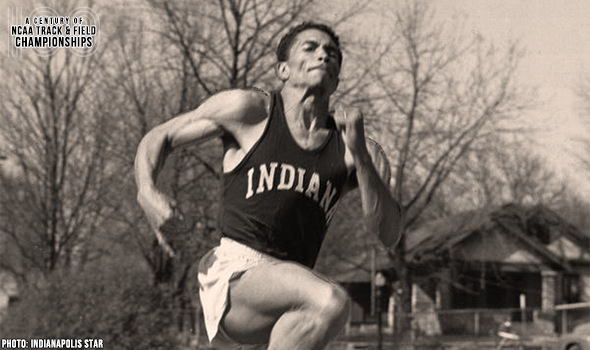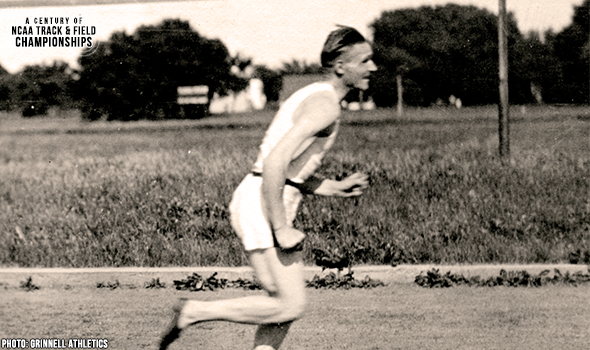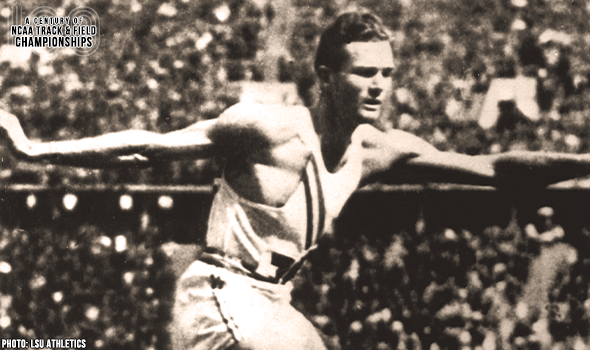
Bell Rang True In Long Jump
Greg Bell of Indiana felt conditions were good enough at the 1957 NCAA Outdoor Track & Field Championships to go after the world record in the long jump.
In fact, after practicing a day before at Texas’ Memorial Stadium, Bell found the runway so fast that he set his starting mark back a foot or so, noted Bob Halford of the Austin Statesman.
The world record – 26-8¼ (8.13m) – was the oldest one on the books at the time, having been set by Jesse Owens of Ohio State on his Day of Days at the 1935 Big Ten meet. And it was Bell himself who had come the closest attempt to it with a 26-6½ (8.09m) jump the previous fall a month before winning gold at the Melbourne Olympics.
Bell went for the record in the NCAA prelims on Day 1, opening up with a safe (for him) 25-8½ (7.83m) that would be good enough to win. On his next attempt Bell added almost a foot, breaking the sand at 26-7 (8.10m) and despite the impressive effort knew it wasn’t perfect.
“That should have been a 27-foot jump,” Bell told Halford afterward. “But I was too far forward on my takeoff and had to drop my feet.”
Bell didn’t improve on his final two attempts in the prelims – which included four rounds at the time – so he waited until the next day’s final to see if he could improve. The Hoosier started off big, but a first-round 26-5 (8.05m) was still short of the record. He followed with two fouls, both estimated to be over 26-feet.
While Bell didn’t eclipse the WR, he did break the meet record of 26-6 (8.07m) set by Willie Steele of San Diego State in 1947. That mark by Steele, which had broken Owens’ MR of 26-1¼ (7.95m) from 1935, had been the closest to Owens until Bell drew closer in 1956.
Bell finished his career in 1960 with a total of 13 jumps over 26-feet, then the most in history.
On May 30, Bell retired after 50 years as Director of Dentistry at Logansport State Hospital in Indiana. Born on this day in 1930, he is one of the oldest living NCAA track & field champions at age 90. His paternal grandfather was 102, and he wants to beat that.
“I’m feeling good now,” he told David Woods of the Indianapolis Star in June. “And I’m having a ball.”
The NCAA and collegiate track & field will mark a momentous milestone in the spring of 2021 -- the 100th anniversary of the NCAA Championships and with that, the NCAA Track & Field Championships. In June 1921, the University of Chicago hosted the first track & field championships in NCAA history.
This point can’t be emphasized enough: Not only was the event the first for NCAA track & field, but the first championships for any sport under the sponsorship of the NCAA.
To celebrate, over each of the next 365 days, the U.S. Track & Field and Cross Country Coaches Association (USTFCCCA) will celebrate moments, student-athletes, and coaches that have made a century’s worth of championships special. From humble beginnings to important historical milestones to the modern-day, collegiate track & field has evolved with the American society.
The 2021 edition of the NCAA Division I Outdoor Track & Field Championships begin with preliminary round action on May 27-29 in Jacksonville, Fla., and College Station, Texas. The championships final site and culmination of the celebration is slated for June 9-12, 2021 at the newly rebuilt Hayward Field in Eugene, Ore.

SIU’s Roggy Dominated The Javelin In 1978
Bob Roggy won the javelin title at the 1978 NCAA DI Outdoor T&F Championships by more than 20 feet. Roggy qualified first for the final with a MR heave of 89.30m (293‑0).

Makusha Made History In Bowerman Year Of 2011
Ngoni Makusha became just the fourth man in meet history to win individual titles in both the 100 and LJ. It was his 3rd career LJ crown and he set a CR in the 100 of 9.89.

George Mason’s Gage Shocked The NCAA LJ In 1988
Nena Gage won the long jump at the 1988 NCAA DI Outdoor T&F Championships in a shocking upset over Gail Devers.

Texas’ Thompson Marveled In NCAA Distance Events
Jerry Thompson won three career distance titles at the NCAA Outdoor T&F Championships. His first came in 1943. Then he won again in 1947 & 1948 after serving in World War II.

Grinnell’s Paulu Sprinted To NCAA History
Leonard Paulu was the first athlete to complete the 100-200 double in NCAA Outdoor Track & Field Championships history in 1922. That also made him the 1st to win back-to-back 100 titles, too.

Scott Won Back-To-Back NCAA Hammer Titles
Candice Scott won back-to-back hammer throw titles at the NCAA DI Outdoor T&F Championships in 2003 & 2004. Scott set a meet record of 69.77m (228-11) in that first year.

Drouin Soared To The Bowerman In 2013
Derek Drouin won two career HJ titles at the NCAA DI Outdoor T&F Championships. When Drouin won in 2013, he was only the fourth man to clear 2.34m (7-8) in meet history.

Watts Made Quick Work Of NCAA 400
Quincy Watts set a meet record in the 400 of 44.00 at the 1992 NCAA DI Outdoor Track & Field Championships. It lasted 25 years until 2017.

Iowa State’s Koll Rolled To 5K-10K Crowns
Lisa Koll won three career titles at the NCAA DI Outdoor T&F Championships in dominant fashion. Her average margin of victory in those 5K & 10K races was 37.73 seconds.

LSU’s Hardin Completed Unique 440-220H Double Twice
The nearly unheard of 440-220H double was so nice that Glenn Hardin did it twice! Hardin became the first to do so in meet history in 1933 and then swept them again in 1934.

